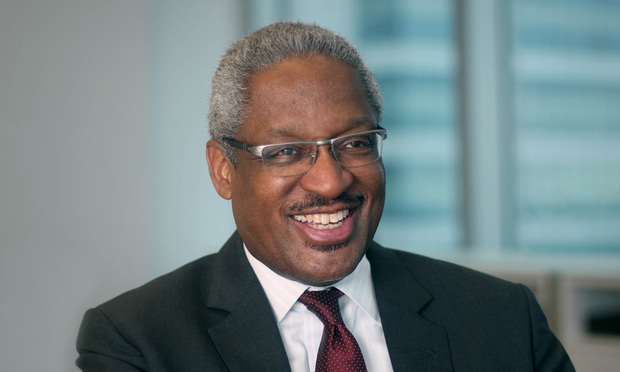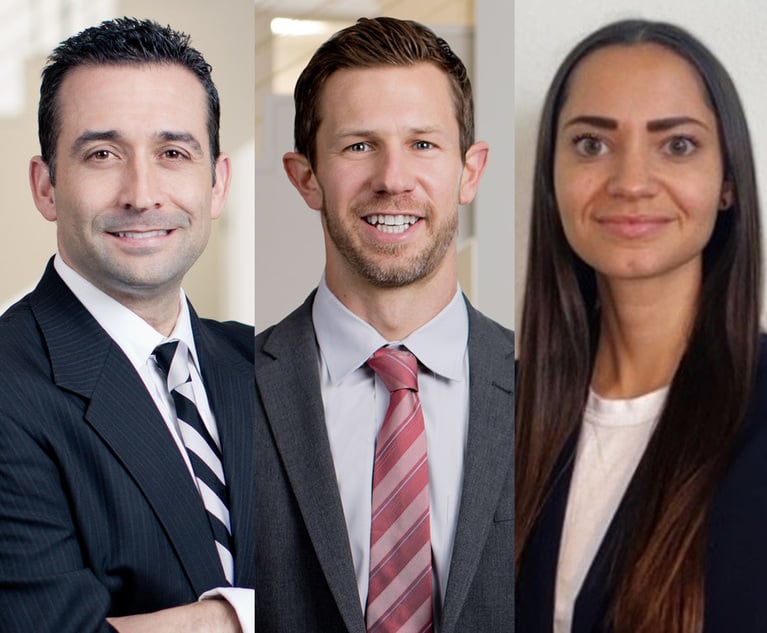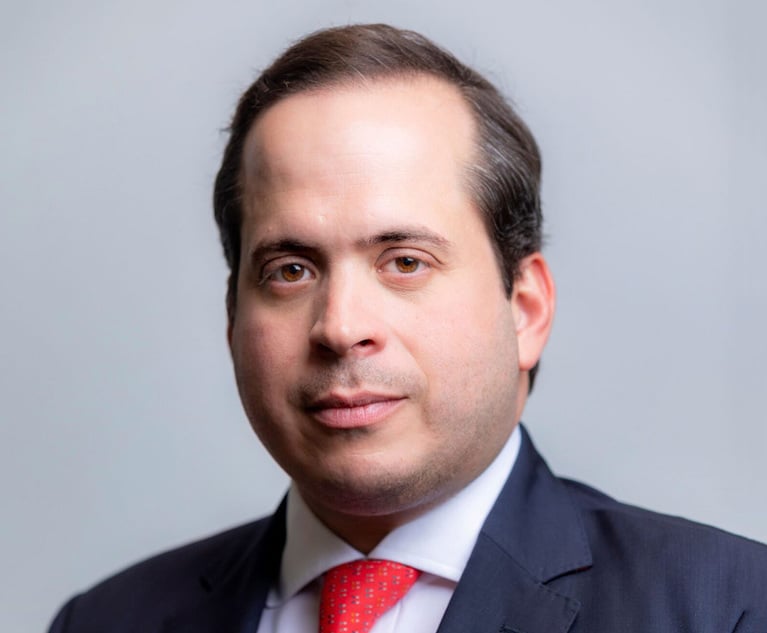Miami's Bilzin Sumberg Practices Are Countercyclical by Design, Return Big Profits
The 100-attorney, single-office law firm considers itself entrepreneurial, client-driven and forward-thinking.
May 22, 2018 at 10:01 AM
11 minute read

Al Dotson, managing partner-elect at Bilzin Sumberg, introduces the midsize Miami law firm in question-and-answer form.
How big is your firm, where is it located, and what are its primary areas of practice and focus?
Bilzin Sumberg is a 100-attorney, single-office commercial law firm located in Miami. Currently in our 20th anniversary, we are a relatively young law firm compared to the long-established Am Law 100 with whom we routinely go toe-to-toe. Our practices — including real estate, land use and zoning, corporate/mergers and acquisitions, finance, joint ventures, international tax, business litigation and public-private partnerships — are highly nuanced, countercyclical by design, and we are one of the most profitable law firms in Florida with profits per partner at $1.46 million in 2017.
We consider our firm to be entrepreneurial, client-driven and forward-thinking, handling some of the most exciting and complex projects in our market. Our one-office model means that we are nimble and collaborative, and able to quickly pull together multidisciplinary teams to respond to client needs.
Eschewing growth for its own sake, we have instead chosen to grow in concert with our clients' needs. As a result, we maintain our home base in Miami while letting technology connect our attorneys with clients all over the United States and throughout the world. Our clients' needs take us far beyond our home base. We regularly service clients whose business and legal needs span the country and much of the world, including Europe, Latin America, Canada, Asia and the Middle East.
Please explain your firm's governance structure and compensation model.
John Sumberg currently serves as the firm's managing partner and works closely with our executive committee, which is charged with steering the firm's business course; identifying objectives that create the greatest opportunities for Bilzin Sumberg's growth and development; ensuring that the process of achieving those objectives aligns with the firm's overall vision of delivering sophisticated legal services with personalized client service; and overseeing the implementation and any necessary modification of the firm's strategy. The executive committee is comprised of both senior and next-generation leaders at the firm.
Strategic issues related to the firm's finances, human capital, business development, firm vision, as well as issues related to external forces such as market conditions and industry growth that impact the firm's direction, are tackled on committee and department levels. Next-generation leaders serve as committee chairs, taking responsibility for key areas related to the firm's strategic plan, such as human capital and corporate culture.
Senior management meets with the firm's partners monthly to underscore the firm's vision and objectives, and to encourage continual relationship-building with clients to better understand their business needs and the direction of their businesses and industries.
For us, the ability to communicate with each other and with the client is much easier in our firm structure than within a global firm, where people are in offices in different places and don't know each other.
This year, we celebrate our 20th anniversary with a planned leadership transition to keep us focused on the future and prepared to adapt as both market conditions and client needs evolve. On Jan. 1, 2019, I will take on the role of managing partner, and John will assume the role of firm chairman. In this capacity, he will remain a member of the firm's executive committee and a part of its management team. Both he and I will also continue to actively represent clients and lead many of the firm's initiatives as we have done together for many years.
What do you view as the biggest opportunities for your firm, and what are the biggest threats?
Two areas in which our law firm has seen a lot of activity recently are public-private partnerships and alternative financing.
Aging infrastructure, scarcity of public funds and recent P3 success in other states and countries have led to the popularity of the P3 model in Florida. In 2017 alone, the firm shepherded more than $2 billion in P3 projects that are collectively bringing new opportunities for transit, public housing and public works to the region. In April, our firm hosted a special roundtable discussion at eMerge Americas on how private innovation can advance public projects. There, I moderated a panel of experts including state Sen. Jeff Brandes, Miami-Dade County Transportation Director Alice Bravo, Florida East Coast Industries Senior Vice President Jose Gonzalez and our very own Eric Singer.
The changing debt financing landscape is also paving way to new opportunities. While traditional banks are still originating loans, they remain cautious and have tightened their requirements, creating a void that alternative lenders have eagerly stepped in to fill. These funding sources tend to be more nimble and adaptive, and thus can compete favorably on a wide range of loans, including mezzanine loans, construction loans and heavy transitional loans. In fact, according to Trepp data, the five largest nonbank lenders — Blackstone Group, Mesa West Capital, Starwood Capital Group, TPG Capital and Mack Real Estate Credit Strategies — collectively funded $20 billion in interim loans last year.
After the recession hit, the prevailing theory was that midsize firms would start to see more work come their way from large clients who could no longer justify paying Big Law rates. What has been your experience?
We continue to find that clients are willing to pay for good work, but with that they demand a firm that understands their business objectives and can provide efficient legal services. This rings especially true for us as our work is not commodity-based.
Are your clients pushing for more alternative fee arrangements, and if so what types? Is your firm amenable to those requests?
More than anything, clients are asking for and demanding predictability with their legal services and fees. We accomplish this by implementing legal project management, which is based on principles of predictability, accountability, transparency and open communication, utilizing software platforms to increase efficiency and control costs.
There is much debate around how law firms can foster the next generation of legal talent. What advantages and disadvantages do midsize firms have in attracting and retaining young lawyers, particularly millennials?
Attracting and retaining top talent is a priority for any law firm. But we believe there are several big advantages to working in a midsize law firm, particularly as it relates to opportunities for lateral acclimation, professional growth and mentorship.
We believe one of the biggest advantages of being a midsize law firm like Bilzin Sumberg is the ability for associates and junior partners to work one-on-one alongside senior partners, and because of our lean matter staffing model, our associates are provided greater opportunities for hands-on learning. This not only leads to a more cohesive firm culture, it makes us more responsive to the needs and concerns of our next generation.
We also employ a robust lateral hire integration program, which is designed to assist lateral hires with the acclimation process. The program designates a veteran partner to act as a mentor and as a point person who a lateral hire can comfortably approach with questions related to work or simply to assist with questions about the ins and outs of the firm. Essentially, this approach is intended to create both informal and formal lines of communication to ensure that the orientation process is successful.
Through the Bilzin Sumberg Academy for Professional Development, we are also onboarding young associates from the start with an intensive training program that teaches them how to get involved in the community and find meaning in their work. Uniquely developed for a new generation of attorneys, the academy provides hands-on training that goes well beyond the traditional new hire orientation. Spanning over two weeks, the program bridges the gap between what is learned in law school and what is necessary in practice, encompassing immersive field trips; presentations by community leaders, firm members and clients; and volunteer experiences that together create a more holistic understanding of what it takes to build a successful practice and become a good corporate citizen.
Does your firm employ any nonlawyer professionals in high-level positions (e.g. COO, business development officer, chief strategy officer, etc.)? If so, why is it advantageous to have a nolawyer in that role? If not, have you considered hiring any?
Bilzin Sumberg has a senior administrative staff comprised of a chief operating officer, chief marketing officer, chief knowledge officer, chief information officer, chief human resources officer and chief legal talent officer. These professionals are predominantly nonlawyers, are experts in their respective fields and provide critical guidance to ensure the firm remains competitive and adaptive to changing market conditions and client needs. Our firm is run like a business, which means we measure success not only by client results but also on the ability to operate efficiently, effectively and with accountability.
What if any technology advancements have you made in your firm in recent years? What are the challenges in implementing tech changes?
We are big believers in investing in technology, and this is rather unique for a firm of our size. For example, we use technology to automate repetitive tasks, thereby freeing our attorneys' time to focus on sophisticated legal work. We also utilize software tools that search data across our platforms, providing a comprehensive 360-degree view of clients and matters, saving hours of time it would otherwise take a person to search content within each platform.
The benefits of our investment in technology have been far-reaching. In the past, younger associates would spend a lot of time doing background research, but with our knowledge management systems in place, much of this research is at their fingertips. Not only does it let our attorneys work more efficiently for clients, but by enabling them to quickly identify information and keep that information up to date, they can get back to clients with answers faster.
The challenge comes with training people to use the technology properly. We do this through a variety of ways, including one-on-one training, online training, group workshops and CLE courses.
What would you say is the most innovative thing your firm has done recently, whether it be internal operations, how you work with clients, etc.?
The firm places high priority on leadership development and invests heavily in it because it recognizes the importance of cultivating the next generation of leaders. One of the programs we have implemented with great success has been our Strategic Analysis Planning Program. The SAPP program employs action learning as a methodology to catapult the next generation of leaders into the heart of firm strategy and vision, while also developing their leadership skills.
SAPP essentially asks groups of participants to solve significant and urgent business problems with no easily identifiable solutions. It builds strong leaders in the process because the participants are learning by doing and delving into leadership in a true-to-life setting.
The result has been stronger skills across the following key areas: collaboration, consensus-building, strategic thinking, and accountability for themselves and others.
Does your firm have a succession plan in place? If so, what challenges do you face in trying to execute that plan? If you don't currently have a plan, is it an issue your firm is thinking about?
A seamless transition to new leadership requires a thoughtful, long-term vision, which is why we began planning for our managing partner succession years ago. In addition to this, the firm continues to cultivate and foster its younger talent and rising stars, aligning them with the broader vision for the firm: one that is built on recruiting and retaining top talent; maintaining deep community engagement; and serving as counselors and trusted advisers who understand our clients' businesses.
This is an exciting time for Miami, and Bilzin Sumberg is playing a central role in its emergence as a global market. Bilzin Sumberg is proud of its continuing contributions to the region and to the national and global legal and business communities in which it operates.
This content has been archived. It is available through our partners, LexisNexis® and Bloomberg Law.
To view this content, please continue to their sites.
Not a Lexis Subscriber?
Subscribe Now
Not a Bloomberg Law Subscriber?
Subscribe Now
NOT FOR REPRINT
© 2025 ALM Global, LLC, All Rights Reserved. Request academic re-use from www.copyright.com. All other uses, submit a request to [email protected]. For more information visit Asset & Logo Licensing.
You Might Like
View All
How Uncertainty in College Athletics Compensation Could Drive Lawsuits in 2025

'As I've Grown Older': John Morgan Looks Back at a Life in Law

Race for Clerk and Comptroller in Miami-Dade: Juan Fernandez-Barquin vs. Sen. Annette Taddeo
11 minute read
Meet Jesus M. Suarez: New Chair of the Eleventh Circuit Judicial Nominating Commission
4 minute readTrending Stories
Who Got The Work
J. Brugh Lower of Gibbons has entered an appearance for industrial equipment supplier Devco Corporation in a pending trademark infringement lawsuit. The suit, accusing the defendant of selling knock-off Graco products, was filed Dec. 18 in New Jersey District Court by Rivkin Radler on behalf of Graco Inc. and Graco Minnesota. The case, assigned to U.S. District Judge Zahid N. Quraishi, is 3:24-cv-11294, Graco Inc. et al v. Devco Corporation.
Who Got The Work
Rebecca Maller-Stein and Kent A. Yalowitz of Arnold & Porter Kaye Scholer have entered their appearances for Hanaco Venture Capital and its executives, Lior Prosor and David Frankel, in a pending securities lawsuit. The action, filed on Dec. 24 in New York Southern District Court by Zell, Aron & Co. on behalf of Goldeneye Advisors, accuses the defendants of negligently and fraudulently managing the plaintiff's $1 million investment. The case, assigned to U.S. District Judge Vernon S. Broderick, is 1:24-cv-09918, Goldeneye Advisors, LLC v. Hanaco Venture Capital, Ltd. et al.
Who Got The Work
Attorneys from A&O Shearman has stepped in as defense counsel for Toronto-Dominion Bank and other defendants in a pending securities class action. The suit, filed Dec. 11 in New York Southern District Court by Bleichmar Fonti & Auld, accuses the defendants of concealing the bank's 'pervasive' deficiencies in regards to its compliance with the Bank Secrecy Act and the quality of its anti-money laundering controls. The case, assigned to U.S. District Judge Arun Subramanian, is 1:24-cv-09445, Gonzalez v. The Toronto-Dominion Bank et al.
Who Got The Work
Crown Castle International, a Pennsylvania company providing shared communications infrastructure, has turned to Luke D. Wolf of Gordon Rees Scully Mansukhani to fend off a pending breach-of-contract lawsuit. The court action, filed Nov. 25 in Michigan Eastern District Court by Hooper Hathaway PC on behalf of The Town Residences LLC, accuses Crown Castle of failing to transfer approximately $30,000 in utility payments from T-Mobile in breach of a roof-top lease and assignment agreement. The case, assigned to U.S. District Judge Susan K. Declercq, is 2:24-cv-13131, The Town Residences LLC v. T-Mobile US, Inc. et al.
Who Got The Work
Wilfred P. Coronato and Daniel M. Schwartz of McCarter & English have stepped in as defense counsel to Electrolux Home Products Inc. in a pending product liability lawsuit. The court action, filed Nov. 26 in New York Eastern District Court by Poulos Lopiccolo PC and Nagel Rice LLP on behalf of David Stern, alleges that the defendant's refrigerators’ drawers and shelving repeatedly break and fall apart within months after purchase. The case, assigned to U.S. District Judge Joan M. Azrack, is 2:24-cv-08204, Stern v. Electrolux Home Products, Inc.
Featured Firms
Law Offices of Gary Martin Hays & Associates, P.C.
(470) 294-1674
Law Offices of Mark E. Salomone
(857) 444-6468
Smith & Hassler
(713) 739-1250






